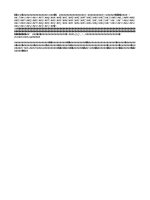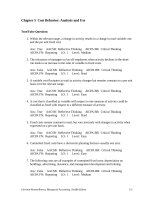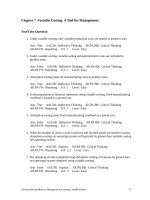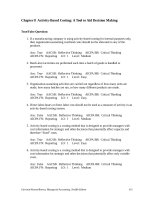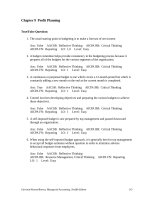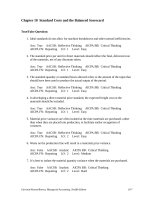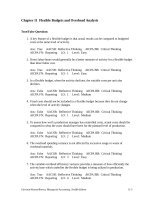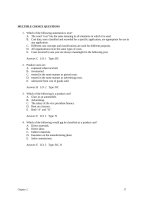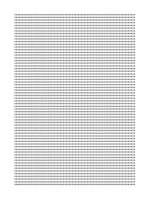Test bank managerial accounting by garrison 13e chapter 08
Bạn đang xem bản rút gọn của tài liệu. Xem và tải ngay bản đầy đủ của tài liệu tại đây (279.37 KB, 102 trang )
Chapter 8 Activity-Based Costing: A Tool to Aid Decision Making
True/False Questions
1. If a manufacturing company is using activity-based costing for internal purposes only,
then organization-sustaining overhead costs should not be allocated to any of the
products.
Ans: True AACSB: Reflective Thinking AICPA BB: Critical Thinking
AICPA FN: Reporting LO: 1 Level: Medium
2. Batch-level activities are performed each time a batch of goods is handled or
processed.
Ans: True AACSB: Reflective Thinking AICPA BB: Critical Thinking
AICPA FN: Reporting LO: 1 Level: Easy
3. Organization-sustaining activities are carried out regardless of how many units are
made, how many batches are run, or how many different products are made.
Ans: True AACSB: Reflective Thinking AICPA BB: Critical Thinking
AICPA FN: Reporting LO: 1 Level: Easy
4. Direct labor-hours or direct labor cost should not be used as a measure of activity in an
activity-based costing system.
Ans: False AACSB: Reflective Thinking AICPA BB: Critical Thinking
AICPA FN: Reporting LO: 1 Level: Medium
5. Activity-based costing is a costing method that is designed to provide managers with
cost information for strategic and other decisions that potentially affect capacity and
therefore “fixed” costs.
Ans: True AACSB: Reflective Thinking AICPA BB: Critical Thinking
AICPA FN: Reporting LO: 1 Level: Easy
6. Activity-based costing is a costing method that is designed to provide managers with
cost information for strategic and other decisions that potentially affect only variable
costs.
Ans: False AACSB: Reflective Thinking AICPA BB: Critical Thinking
AICPA FN: Reporting LO: 1 Level: Medium
Garrison/Noreen/Brewer, Managerial Accounting, Twelfth Edition
8-5
Chapter 8 Activity-Based Costing: A Tool to Aid Decision Making
7. A duration driver provides a measure of the amount of time required to perform an
activity.
Ans: True AACSB: Reflective Thinking AICPA BB: Critical Thinking
AICPA FN: Reporting LO: 1 Level: Medium
8. In general, transaction drivers are more accurate measures of the consumption of
resources than duration drivers.
Ans: False AACSB: Reflective Thinking AICPA BB: Critical Thinking
AICPA FN: Reporting LO: 1 Level: Medium
9. The costs of idle capacity should not be assigned to products in activity-based costing.
Ans: True AACSB: Reflective Thinking AICPA BB: Critical Thinking
AICPA FN: Reporting LO: 1 Level: Easy
10. In traditional costing systems, all manufacturing costs are assigned to products--even
manufacturing costs that are not caused by the products.
Ans: True AACSB: Reflective Thinking AICPA BB: Critical Thinking
AICPA FN: Reporting LO: 1 Level: Medium
11. Activity-based costing involves a two-stage allocation in which overhead costs are
first assigned to departments and then to jobs on the basis of direct labor hours.
Ans: False AACSB: Reflective Thinking AICPA BB: Critical Thinking
AICPA FN: Reporting LO: 2,4 Level: Medium
12. In activity-based costing, some costs may be broken down and assigned to two activity
cost pools. For example, part of a supervisor's salary may be classified as a productlevel activity and part of it may be classified as a batch-level activity.
Ans: True AACSB: Reflective Thinking AICPA BB: Critical Thinking
AICPA FN: Reporting LO: 2 Level: Medium
13. Activity rates in activity-based costing are computed by dividing costs from the firststage allocations by the activity measure for each activity cost pool.
Ans: True AACSB: Reflective Thinking AICPA BB: Critical Thinking
AICPA FN: Reporting LO: 3 Level: Medium
8-6
Garrison/Noreen/Brewer, Managerial Accounting, Twelfth Edition
Chapter 8 Activity-Based Costing: A Tool to Aid Decision Making
14. In the second-stage allocation in activity-based costing, activity rates are used to apply
costs to products, customers, and other cost objects.
Ans: True AACSB: Reflective Thinking AICPA BB: Critical Thinking
AICPA FN: Reporting LO: 4 Level: Medium
15. When a company shifts from a traditional cost system in which manufacturing
overhead is applied based on direct labor-hours to an activity-based costing system in
which there are batch-level and product-level costs, the unit product costs of high
volume products typically decrease whereas the unit product costs of low volume
products typically increase.
Ans: True AACSB: Analytic
AICPA FN: Reporting LO: 8
AICPA BB: Critical Thinking
Level: Medium
Multiple Choice Questions
16. Which terms would make the following sentence true? Manufacturing companies that
benefit the most from activity-based costing are those where overhead costs are a
_________ percentage of total product cost and where there is ___________ diversity
among the various products that they produce.
A) low, little
B) low, considerable
C) high, little
D) high, considerable
Ans: D AACSB: Analytic AICPA BB: Critical Thinking
AICPA FN: Reporting LO: 1 Level: Medium
17. Would factory security and assembly activities be best classified at an appliance
manufacturing plant as unit-level, batch-level, product-level, or organizationsustaining?
Security
A)
Product
B)
Batch
C) Organization
D) Organization
Assembl
y
Unit
Batch
Unit
Product
Ans: C AACSB: Analytic AICPA BB: Critical Thinking
AICPA FN: Reporting LO: 1 Level: Medium
Garrison/Noreen/Brewer, Managerial Accounting, Twelfth Edition
8-7
Chapter 8 Activity-Based Costing: A Tool to Aid Decision Making
18. Which of the following would be an acceptable measure of activity for a material
handling activity cost pool?
A)
B)
C)
D)
Number of
Weight of
material moves material moved
Yes
Yes
No
Yes
Yes
No
No
No
Ans: A AACSB: Analytic AICPA BB: Critical Thinking
AICPA FN: Reporting LO: 1 Level: Medium
19. An activity-based costing system that is designed for internal decision-making
generally will not conform to generally accepted accounting principles. Which of the
following is NOT a reason for this happening?
A) Some manufacturing costs (i.e., the costs of idle capacity and organizationsustaining costs) will not be assigned to products.
B) Some nonmanufacturing costs are assigned to products.
C) Allocation bases other than direct labor-hours, direct labor cost, and machinehours are used.
D) First-stage allocations may be based on subjective interview data.
Ans: C AACSB: Analytic AICPA BB: Critical Thinking
AICPA FN: Reporting LO: 1 Level: Hard
20. Providing the power required to run production equipment is an example of a:
A) Unit-level activity.
B) Batch-level activity.
C) Product-level activity.
D) Organization-sustaining activity.
Ans: A AACSB: Analytic AICPA BB: Critical Thinking
AICPA FN: Reporting LO: 1 Level: Medium
21. Parts administration is an example of a:
A) Unit-level activity.
B) Batch-level activity.
C) Product-level activity.
D) Organization-sustaining.
Ans: C
8-8
LO: 1
Level: Medium
Garrison/Noreen/Brewer, Managerial Accounting, Twelfth Edition
Chapter 8 Activity-Based Costing: A Tool to Aid Decision Making
22. If a cost object such as a product or customer has a negative green margin, then:
A) its red margin will be positive.
B) its red margin may be either positive or negative.
C) its red margin will be negative.
D) its red margin will be zero.
Ans: C AACSB: Analytic AICPA BB: Critical Thinking
AICPA FN: Reporting Appendix: 8A LO: 6 Level: Medium
23. Tatman Corporation uses an activity-based costing system with the following three
activity cost pools:
Activity Cost Pool
Total Activity
Fabrication......................... 10,000 machine-hours
Order processing................
800 orders
Other..................................
Not applicable
The Other activity cost pool is used to accumulate costs of idle capacity and
organization-sustaining costs.
The company has provided the following data concerning its costs:
Wages and salaries.............
Depreciation.......................
Occupancy..........................
Total...................................
$320,000
220,000
120,000
$660,000
The distribution of resource consumption across activity cost pools is given below:
Activity Cost Pools
Order
Fabrication Processing
Other
Wages and salaries.......
20%
65%
15%
Depreciation.................
15%
35%
50%
Occupancy....................
5%
70%
25%
Total
100%
100%
100%
The activity rate for the Fabrication activity cost pool is closest to:
A) $3.30 per machine-hour
B) $13.20 per machine-hour
C) $10.30 per machine-hour
D) $8.80 per machine-hour
Ans: C AACSB: Analytic AICPA BB: Critical Thinking
AICPA FN: Reporting LO: 2,3 Level: Medium
Garrison/Noreen/Brewer, Managerial Accounting, Twelfth Edition
8-9
Chapter 8 Activity-Based Costing: A Tool to Aid Decision Making
Solution:
Total Fabrication Cost:
Wages and salaries: 20% × $320,000....... $ 64,000
Depreciation: 15% × $220,000.................
33,000
Occupancy: 5% × $120,000.....................
6,000
Total.......................................................... $103,000
(a) ÷ (b)
Activity Cost Pool
Fabrication
(a)
Total Cost
$103,000
(b)
Total Activity
10,000 machine-hours
Activity Rate
$10.30 per machine-hour
24. Leaper Corporation uses an activity-based costing system with the following three
activity cost pools:
Activity Cost Pool
Fabrication.........................
Order processing................
Other..................................
Total Activity
40,000 machine-hours
200 orders
Not applicable
The Other activity cost pool is used to accumulate costs of idle capacity and
organization-sustaining costs.
The company has provided the following data concerning its costs:
Wages and salaries.......
Depreciation.................
Occupancy....................
Total.............................
$360,000
140,000
160,000
$660,000
The distribution of resource consumption across activity cost pools is given below:
Wages and salaries.......
Depreciation.................
Occupancy....................
Activity Cost Pools
Order
Fabrication Processing
Other
35%
40%
25%
5%
55%
40%
30%
45%
25%
Total
100%
100%
100%
The activity rate for the Order Processing activity cost pool is closest to:
A) $1,485 per order
B) $1,540 per order
C) $1,465 per order
D) $1,320 per order
8-10
Garrison/Noreen/Brewer, Managerial Accounting, Twelfth Edition
Chapter 8 Activity-Based Costing: A Tool to Aid Decision Making
Ans: C AACSB: Analytic AICPA BB: Critical Thinking
AICPA FN: Reporting LO: 2,3 Level: Medium
Solution:
Total Order Processing Cost:
Wages and salaries: 40% × $360,000....... $144,000
Depreciation: 55% × $140,000.................
77,000
Occupancy: 45% × $160,000...................
72,000
Total.......................................................... $293,000
(a) ÷ (b)
Activity Cost Pool
Order Processing
(a)
Total Cost
$293,000
(b)
Total Activity
200 orders
Garrison/Noreen/Brewer, Managerial Accounting, Twelfth Edition
Activity Rate
$1,465 per order
8-11
Chapter 8 Activity-Based Costing: A Tool to Aid Decision Making
25. Huelskamp Corporation has provided the following data concerning its overhead costs
for the coming year:
Wages and salaries.......
Depreciation.................
Rent..............................
Total.............................
$360,000
120,000
180,000
$660,000
The company has an activity-based costing system with the following three activity
cost pools and estimated activity for the coming year:
Activity Cost Pool
Total Activity
Assembly...................... 60,000 labor-hours
Order processing..........
400 orders
Other............................
Not applicable
The Other activity cost pool does not have a measure of activity; it is used to
accumulate costs of idle capacity and organization-sustaining costs.
The distribution of resource consumption across activity cost pools is given below:
Wages and salaries.......
Depreciation.................
Rent..............................
Activity Cost Pools
Order
Assembly Processing Other
25%
65%
10%
15%
45%
40%
35%
40%
25%
Total
100%
100%
100%
The activity rate for the Assembly activity cost pool is closest to:
A) $2.65 per labor-hour
B) $3.85 per labor-hour
C) $2.85 per labor-hour
D) $2.75 per labor-hour
Ans: C AACSB: Analytic AICPA BB: Critical Thinking
AICPA FN: Reporting LO: 2,3 Level: Medium
8-12
Garrison/Noreen/Brewer, Managerial Accounting, Twelfth Edition
Chapter 8 Activity-Based Costing: A Tool to Aid Decision Making
Solution:
Total Assembly Cost:
Wages and salaries: 25% × $360,000....... $ 90,000
Depreciation: 15% × $120,000.................
18,000
Rent: 35% × $180,000..............................
63,000
Total.......................................................... $171,000
(a) ÷ (b)
Activity Cost Pool
Assembly
(a)
Total Cost
$171,000
(b)
Total Activity
60,000 labor-hours
Garrison/Noreen/Brewer, Managerial Accounting, Twelfth Edition
Activity Rate
$2.85 per labor-hour
8-13
Chapter 8 Activity-Based Costing: A Tool to Aid Decision Making
26. Bennette Corporation has provided the following data concerning its overhead costs
for the coming year:
Wages and salaries.......
Depreciation.................
Rent..............................
Total.............................
$340,000
120,000
140,000
$600,000
The company has an activity-based costing system with the following three activity
cost pools and estimated activity for the coming year:
Activity Cost Pool
Assembly...................
Order processing.......
Other.........................
Total Activity
30,000 labor-hours
500 orders
Not applicable
The Other activity cost pool does not have a measure of activity; it is used to
accumulate costs of idle capacity and organization-sustaining costs.
The distribution of resource consumption across activity cost pools is given below:
Wages and salaries.......
Depreciation.................
Rent..............................
Assembly
40%
15%
35%
Activity Cost Pools
Order
Processing
Other
35%
25%
45%
40%
30%
35%
Total
100%
100%
100%
The activity rate for the Order Processing activity cost pool is closest to:
A) $430 per order
B) $420 per order
C) $360 per order
D) $440 per order
Ans: A AACSB: Analytic AICPA BB: Critical Thinking
AICPA FN: Reporting LO: 2,3 Level: Medium
8-14
Garrison/Noreen/Brewer, Managerial Accounting, Twelfth Edition
Chapter 8 Activity-Based Costing: A Tool to Aid Decision Making
Solution:
Total Order Processing Cost:
Wages and salaries: 35% × $340,000....... $119,000
Depreciation: 45% × $120,000.................
54,000
Rent: 30% × $140,000..............................
42,000
Total.......................................................... $215,000
(a) ÷
(b)
Activity Cost Pool
Order Processing
(a)
Total Cost
$215,000
(b)
Total Activity
500 orders
Activity Rate
$430 per order
27. Eccles Corporation uses an activity-based costing system with three activity cost
pools. The company has provided the following data concerning its costs and its
activity based costing system:
Costs:
Wages and salaries............. $340,000
Depreciation....................... 180,000
Utilities............................... 200,000
Total................................... $720,000
Distribution of resource consumption:
Wages and salaries.......
Depreciation.................
Utilities.........................
Assembly
20%
15%
5%
Activity Cost Pools
Setting Up
Other
60%
20%
35%
50%
55%
40%
Total
100%
100%
100%
How much cost, in total, would be allocated in the first-stage allocation to the
Assembly activity cost pool?
A) $144,000
B) $96,000
C) $36,000
PD) $105,000
Ans: D AACSB: Analytic AICPA BB: Critical Thinking
AICPA FN: Reporting LO: 2 Level: Medium
Garrison/Noreen/Brewer, Managerial Accounting, Twelfth Edition
8-15
Chapter 8 Activity-Based Costing: A Tool to Aid Decision Making
Solution:
Total Assembly Cost:
Wages and salaries: 20% × $340,000....... $ 68,000
Depreciation: 15% × $180,000.................
27,000
Utilities: 5% × $200,000...........................
10,000
Total.......................................................... $105,000
28. Mayeux Corporation uses an activity-based costing system with three activity cost
pools. The company has provided the following data concerning its costs and its
activity based costing system:
Costs:
Wages and salaries.............
Depreciation.......................
Utilities...............................
Total...................................
$320,000
160,000
240,000
$720,000
Distribution of resource consumption:
Wages and salaries.......
Depreciation.................
Utilities.........................
Assembly
50%
10%
15%
Activity Cost Pools
Setting Up
Other
40%
10%
55%
35%
50%
35%
Total
100%
100%
100%
How much cost, in total, would be allocated in the first-stage allocation to the Setting
Up activity cost pool?
A) $360,000
B) $336,000
C) $288,000
D) $348,000
Ans: B AACSB: Analytic AICPA BB: Critical Thinking
AICPA FN: Reporting LO: 2 Level: Medium
Solution:
Total Setting Up Cost:
Wages and salaries: 40% × $320,000....... $128,000
Depreciation: 55% × $160,000.................
88,000
Utilities: 50% × $240,000......................... 120,000
Total.......................................................... $336,000
8-16
Garrison/Noreen/Brewer, Managerial Accounting, Twelfth Edition
Chapter 8 Activity-Based Costing: A Tool to Aid Decision Making
29. Gutknecht Corporation uses an activity-based costing system with three activity cost
pools. The company has provided the following data concerning its costs and its
activity based costing system:
Costs:
Wages and salaries.............
Depreciation.......................
Utilities...............................
Total...................................
$300,000
180,000
240,000
$720,000
Distribution of resource consumption:
Wages and salaries.........
Depreciation..................
Utilities..........................
Assembly
35%
5%
10%
Activity Cost Pools
Setting Up
Other
40%
25%
60%
35%
60%
30%
Total
100%
100%
100%
How much cost, in total, would be allocated in the first-stage allocation to the Other
activity cost pool?
A) $138,000
B) $210,000
C) $180,000
D) $216,000
Ans: B AACSB: Analytic AICPA BB: Critical Thinking
AICPA FN: Reporting LO: 2 Level: Medium
Solution:
Total Other Cost:
Wages and salaries: 25% × $300,000....... $ 75,000
Depreciation: 35% × $180,000.................
63,000
Utilities: 30% × $240,000.........................
72,000
Total.......................................................... $210,000
Garrison/Noreen/Brewer, Managerial Accounting, Twelfth Edition
8-17
Chapter 8 Activity-Based Costing: A Tool to Aid Decision Making
30. Lakatos Corporation uses an activity-based costing system with three activity cost
pools. The company has provided the following data concerning its costs:
Costs:
Wages and salaries.............
Depreciation.......................
Occupancy..........................
Total...................................
$420,000
240,000
220,000
$880,000
The distribution of resource consumption across the three activity cost pools is given
below:
Activity Cost Pools
Order
Fabricating Processing
Other
Wages and salaries.........
10%
75%
15%
Depreciation..................
5%
50%
45%
Occupancy.....................
30%
35%
35%
Total
100%
100%
100%
How much cost, in total, would be allocated in the first-stage allocation to the
Fabricating activity cost pool?
A) $88,000
B) $132,000
C) $264,000
D) $120,000
Ans: D AACSB: Analytic AICPA BB: Critical Thinking
AICPA FN: Reporting LO: 2 Level: Medium
Solution:
Total Fabricating Cost:
Wages and salaries: 10% × $420,000....... $ 42,000
Depreciation: 5% × $240,000...................
12,000
Occupancy: 30% × $220,000...................
66,000
Total.......................................................... $120,000
8-18
Garrison/Noreen/Brewer, Managerial Accounting, Twelfth Edition
Chapter 8 Activity-Based Costing: A Tool to Aid Decision Making
31. Perl Corporation uses an activity-based costing system with three activity cost pools.
The company has provided the following data concerning its costs:
Costs:
Wages and salaries.............
Depreciation.......................
Occupancy..........................
Total...................................
$360,000
200,000
100,000
$660,000
The distribution of resource consumption across the three activity cost pools is given
below:
Activity Cost Pools
Order
Fabricating Processing
Other
Wages and salaries.........
15%
60%
25%
Depreciation..................
20%
35%
45%
Occupancy.....................
25%
50%
25%
Total
100%
100%
100%
How much cost, in total, would be allocated in the first-stage allocation to the Order
Processing activity cost pool?
A) $336,000
B) $319,000
C) $330,000
D) $396,000
Ans: A AACSB: Analytic AICPA BB: Critical Thinking
AICPA FN: Reporting LO: 2 Level: Medium
Solution:
Total Order Processing Cost:
Wages and salaries: 60% × $360,000....... $216,000
Depreciation: 35% × $200,000.................
70,000
Occupancy: 50% × $100,000...................
50,000
Total.......................................................... $336,000
Garrison/Noreen/Brewer, Managerial Accounting, Twelfth Edition
8-19
Chapter 8 Activity-Based Costing: A Tool to Aid Decision Making
32. Hosley Corporation uses an activity-based costing system with three activity cost
pools. The company has provided the following data concerning its costs:
Costs:
Wages and salaries.......
Depreciation.................
Occupancy....................
Total.............................
$360,000
100,000
120,000
$580,000
The distribution of resource consumption across the three activity cost pools is given
below:
Activity Cost Pools
Order
Fabricating Processing
Other
Total
Wages and salaries.........
50%
40%
10%
100%
Depreciation..................
10%
45%
45%
100%
Occupancy.....................
5%
60%
35%
100%
How much cost, in total, would be allocated in the first-stage allocation to the Other
activity cost pool?
A) $123,000
B) $174,000
C) $58,000
D) $203,000
Ans: A AACSB: Analytic AICPA BB: Critical Thinking
AICPA FN: Reporting LO: 2 Level: Medium
Solution:
Total Other Cost:
Wages and salaries: 10% × $360,000....... $ 36,000
Depreciation: 45% × $100,000.................
45,000
Occupancy: 35% × $120,000...................
42,000
Total.......................................................... $123,000
8-20
Garrison/Noreen/Brewer, Managerial Accounting, Twelfth Edition
Chapter 8 Activity-Based Costing: A Tool to Aid Decision Making
33. Feldpausch Corporation has provided the following data from its activity-based
costing system:
Activity Cost Pool
Assembly......................
Processing orders.........
Inspection.....................
Total Cost
$1,137,360
$28,479
$97,155
Total Activity
84,000 machine-hours
1,100 orders
1,270 inspection-hours
The company makes 470 units of product W26B a year, requiring a total of 660
machine-hours, 50 orders, and 40 inspection-hours per year. The product's direct
materials cost is $40.30 per unit and its direct labor cost is $42.22 per unit. The
product sells for $118.00 per unit. According to the activity-based costing system, the
product margin for product W26B is:
A) $6,444.70 per unit
B) $4,679.20 per unit
C) $3,384.70 per unit
D) $16,675.60 per unit
Ans: C AACSB: Analytic AICPA BB: Critical Thinking
AICPA FN: Reporting LO: 3,4,5 Level: Medium
Solution:
Activity Cost Pool
Assembly
(a)
Total Cost
$1,137,360
Processing Orders
Inspection
28,479
97,155
(b)
Total Activity
84,000 machinehours
1,100 orders
1,270 inspectionhours
(a) ÷ (b)
Activity Rate
$13.54 per
machine-hour
$25.89 per order
$76.50 per
inspection-hour
Calculation of Overhead Costs:
Activity Cost Pool
Assembly
Processing Orders
Inspection
(a)
Activity Rate
$13.54 per MH
$25.89 per order
$76.50 per IH
(b)
Total Activity
660 MHs
50 orders
40 IHs
Garrison/Noreen/Brewer, Managerial Accounting, Twelfth Edition
(a) × (b)
ABC Cost
$8,936.40
$1,294.50
$3,060.00
8-21
Chapter 8 Activity-Based Costing: A Tool to Aid Decision Making
Sales.............................................................................$55,460.00
Costs:
Direct materials (470 × $40.30)...............................
$18,941.00
Direct labor (470 × $42.22)......................................
19,843.40
Assembly..................................................................
8,936.40
Processing.................................................................
1,294.50
Inspection.................................................................
3,060.00
52,075.30
Product margin.............................................................$ 3,384.70
34. Houseal Corporation has provided the following data from its activity-based costing
system:
Activity Cost Pool
Assembly......................
Processing orders.........
Inspection.....................
Total Cost
$613,250
$46,170
$146,110
Total Activity
55,000 machine-hours
1,500 orders
1,900 inspection-hours
Data concerning one of the company’s products, Product W58B, appear below:
Selling price per unit............................
Direct materials cost per unit...............
Direct labor cost per unit......................
Annual unit production and sales.........
Annual machine-hours.........................
Annual orders.......................................
Annual inspection-hours......................
$113.70
$48.14
$11.62
360
1,040
60
30
According to the activity-based costing system, the product margin for product W58B
is:
A) $3,668.60
B) $5,975.60
C) $5,515.40
D) $19,418.40
Ans: A AACSB: Analytic AICPA BB: Critical Thinking
AICPA FN: Reporting LO: 3,4,5 Level: Medium
8-22
Garrison/Noreen/Brewer, Managerial Accounting, Twelfth Edition
Chapter 8 Activity-Based Costing: A Tool to Aid Decision Making
Solution:
Activity Cost Pool
Assembly
(a)
Total Cost
$613,250
Processing Orders
Inspection
46,170
146,110
(b)
Total Activity
55,000 machinehours
1,500 orders
1,900 inspectionhours
(a) ÷ (b)
Activity Rate
$11.15 per
machine-hour
$30.78 per order
$76.90 per
inspection-hour
Calculation of Overhead Costs:
Activity Cost Pool
Assembly
Processing Orders
Inspection
(a)
Activity Rate
$11.15 per MH
$30.78 per order
$76.90 per IH
(b)
Total Activity
1,040 MHs
60 orders
30 IHs
(a) × (b)
ABC Cost
$11,596.00
$1,846.80
$2,307.00
Sales (360 × $113.70)..................................................$40,932.00
Costs:
Direct materials (360 × $48.14)...............................
$17,330.40
Direct labor (360 × $11.62)......................................
4,183.20
Assembly..................................................................
11,596.00
Processing.................................................................
1,846.80
Inspection.................................................................
2,307.00
37,263.40
Product margin.............................................................$ 3,668.60
Garrison/Noreen/Brewer, Managerial Accounting, Twelfth Edition
8-23
Chapter 8 Activity-Based Costing: A Tool to Aid Decision Making
35. Dobles Corporation has provided the following data from its activity-based costing
system:
Activity Cost Pool
Assembly......................
Processing orders.........
Inspection.....................
Total Cost
$228,060
$34,068
$125,560
Total Activity
18,000 machine-hours
1,200 orders
1,720 inspection-hours
The company makes 420 units of product D28K a year, requiring a total of 460
machine-hours, 80 orders, and 10 inspection-hours per year. The product's direct
materials cost is $48.96 per unit and its direct labor cost is $25.36 per unit. According
to the activity-based costing system, the average cost of product D28K is closest to:
A) $95.34 per unit
B) $93.60 per unit
C) $74.32 per unit
D) $89.93 per unit
Ans: A AACSB: Analytic AICPA BB: Critical Thinking
AICPA FN: Reporting LO: 3,4 Level: Medium
Solution:
Activity Cost Pool
Assembly
(a)
Total Cost
$228,060
Processing Orders
Inspection
34,068
125,560
(b)
Total Activity
18,000 machinehours
1,200 orders
1,720 inspectionhours
Average Cost of Product D28K:
Direct materials..........................................
Direct labor................................................
Assembly [($12.67 × 460) ÷ 420]..............
Processing orders [($28.39 × 80) ÷ 420]. . .
Inspection [($73.00 × 10) ÷ 420]...............
8-24
(a) ÷ (b)
Activity Rate
$12.67 per
machine-hour
$28.39 per order
$73.00 per
inspection-hour
$48.96
25.36
13.88
5.40
1.74
$95.34
Garrison/Noreen/Brewer, Managerial Accounting, Twelfth Edition
Chapter 8 Activity-Based Costing: A Tool to Aid Decision Making
36. Paparo Corporation has provided the following data from its activity-based costing
system:
Activity Cost Pool
Assembly......................
Processing orders.........
Inspection.....................
Total Cost
$846,040
$64,056
$102,408
Total Activity
52,000 machine-hours
1,700 orders
1,360 inspection-hours
Data concerning the company’s product Q79Y appear below:
Annual unit production and sales.........
450
Annual machine-hours......................... 1,080
Annual number of orders.....................
70
Annual inspection hours......................
20
Direct materials cost............................ $44.00 per unit
Direct labor cost................................... $41.03 per unit
According to the activity-based costing system, the average cost of product Q79Y is
closest to:
A) $133.29 per unit
B) $85.03 per unit
C) $127.43 per unit
D) $129.94 per unit
Ans: A AACSB: Analytic AICPA BB: Critical Thinking
AICPA FN: Reporting LO: 3,4 Level: Medium
Garrison/Noreen/Brewer, Managerial Accounting, Twelfth Edition
8-25
Chapter 8 Activity-Based Costing: A Tool to Aid Decision Making
Solution:
Activity Cost Pool
Assembly
(a)
Total Cost
$846,040
Processing Orders
Inspection
64,056
102,408
(b)
Total Activity
52,000 machinehours
1,700 orders
1,360 inspectionhours
Average Cost of Product Q79Y:
Direct materials..........................................
Direct labor................................................
Assembly [($16.27 × 1,080) ÷ 450]...........
Processing orders [($37.68 × 70) ÷ 450]. . .
Inspection [($75.30 × 20) ÷ 450]...............
(a) ÷ (b)
Activity Rate
$16.27 per
machine-hour
$37.68 per order
$75.30 per
inspection-hour
$ 44.00
41.03
39.05
5.86
3.35
$133.29
37. Millner Corporation has provided the following data from its activity-based costing
accounting system:
Activity Cost Pools
Designing products............
Setting up batches..............
Assembling products..........
Total Cost
$1,372,448
$33,300
$126,160
Total Activity
7,798 product design hours
740 batch set-ups
6,640 assembly hours
The activity rate for the “designing products” activity cost pool is closest to:
A) $101 per product design hour
B) $1,372,448 per product design hour
C) $176 per product design hour
D) $57 per product design hour
Ans: C AACSB: Analytic AICPA BB: Critical Thinking
AICPA FN: Reporting LO: 3 Level: Easy
Solution:
Activity Cost Pool
Designing Products
8-26
(a)
Total Cost
$1,372,448
(b)
Total Activity
7,798 PDHs
(a) ÷ (b)
Activity Rate
$176 per PDH
Garrison/Noreen/Brewer, Managerial Accounting, Twelfth Edition
Chapter 8 Activity-Based Costing: A Tool to Aid Decision Making
38. Data concerning three of the activity cost pools of Salcido LLC, a legal firm, have
been provided below:
Activity Cost Pools
Researching legal issues....
Meeting with clients...........
Preparing documents..........
Total Cost
Total Activity
$20,480
640 research hours
$1,182,239 7,253 meeting hours
$91,840 5,740 documents
The activity rate for the “meeting with clients” activity cost pool is closest to:
A) $95 per meeting hour
B) $61 per meeting hour
C) $163 per meeting hour
D) $1,182,239 per meeting hour
Ans: C AACSB: Analytic AICPA BB: Critical Thinking
AICPA FN: Reporting LO: 3 Level: Easy
Solution:
(a)
Activity Cost Pool
Total Cost
Meeting with clients $1,182,239
(b)
Total Activity
7,253 meeting
hours
Garrison/Noreen/Brewer, Managerial Accounting, Twelfth Edition
(a) ÷ (b)
Activity Rate
$163 per
meeting hour
8-27
Chapter 8 Activity-Based Costing: A Tool to Aid Decision Making
39. Gould Corporation uses the following activity rates from its activity-based costing to
assign overhead costs to products:
Activity Cost Pools
Setting up batches..........................
Processing customer orders............
Assembling products......................
Activity Rate
$59.06 per batch
$72.66 per customer order
$3.75 per assembly hour
Data concerning two products appear below:
Number of batches.........................
Number of customer orders...........
Number of assembly hours............
Product K91B Product F65O
84
50
32
43
483
890
How much overhead cost would be assigned to Product K91B using the activity-based
costing system?
A) $9,097.41
B) $81,146.53
C) $4,961.04
D) $135.47
Ans: A AACSB: Analytic AICPA BB: Critical Thinking
AICPA FN: Reporting LO: 4 Level: Easy
Solution:
Activity Cost Pool
Setting up batches
Processing customer
orders
Assembling products
8-28
(a)
Activity Rate
$59.06 per
batch
$72.66 per
order
$3.75 per AH
(b)
Total Activity
84 batches
(a) × (b)
ABC Cost
$4,961.04
32 orders
2,325.12
483 AHs
1,811.25
$9,097.41
Garrison/Noreen/Brewer, Managerial Accounting, Twelfth Edition
Chapter 8 Activity-Based Costing: A Tool to Aid Decision Making
40. Hane Corporation uses the following activity rates from its activity-based costing to
assign overhead costs to products:
Activity Cost Pools
Assembling products......................
Processing customer orders............
Setting up batches..........................
Activity Rate
$8.90 per assembly hour
$31.23 per customer order
$43.72 per batch
Data for one of the company’s products follow:
Number of assembly hours............
Number of customer orders...........
Number of batches.........................
Product U94W
389
53
61
How much overhead cost would be assigned to Product U94W using the activitybased costing system?
A) $42,176.55
B) $83.85
C) $7,784.21
D) $2,666.92
Ans: C AACSB: Analytic AICPA BB: Critical Thinking
AICPA FN: Reporting LO: 4 Level: Easy
Solution:
Activity Cost Pool
Assembling products
Processing customer
orders
Setting up batches
(a)
Activity Rate
$8.90 per AH
$31.23 per
order
$43.72 per
batch
(b)
Total Activity
389 AHs
53 orders
(a) × (b)
ABC Cost
$3,462.10
1,655.19
61 batches
2,666.92
$7,784.21
Garrison/Noreen/Brewer, Managerial Accounting, Twelfth Edition
8-29
